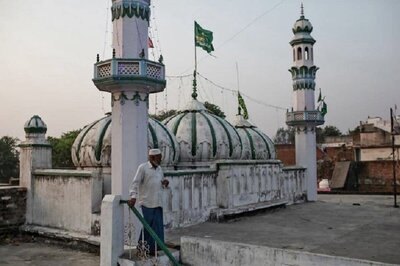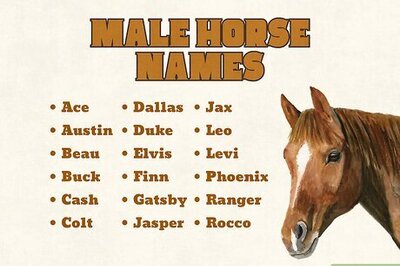
views
What happens at the end of Conclave?
Cardinal Lawrence discovers the newly elected pope is intersex. After the new pope Cardinal Benitez is elected, Monsignor O’Malley reveals that the secret surgical procedure that Benitez had an appointment for in Switzerland was a hysterectomy to remove a uterus and ovaries. Lawrence confronts Benitez, who tells him that he is intersex and was born with both male and female organs. He explains that he refused the surgery because he wants to honor how God made him. Benitez tells Lawrence that his decision to remain as he is can help him be a good pope: “Perhaps it is my difference that will make me more useful. I know what it is to exist between the world’s certainties.” This dialogue echoes what Lawrence said earlier in the film: “Our faith is a living thing precisely because it walks hand-in-hand with doubt.” It’s understood that the previous pope was the only person who knew about Benitez being intersex. Benitez chooses the name "Innocent" as the pope to reflect a hopeful idea of purity without prejudice.
Cardinal Lawrence chooses to keep Benitez’s secret from the conclave. Throughout the film, Lawrence reveals any new information he comes across so that the conclave can make an honest, informed decision when electing the new pope. Here, Lawrence chooses to keep Benitez’s secret because, unlike some of the other Cardinals, Benitez is an honest and sincere man. Lawrence knows the decision has already been made and believes that the Church can benefit from the progressive change that Benitez can bring to the papacy. Lawrence doesn’t want to betray Cardinal Benitez, especially since the previous pope knew about Benitez being intersex and had elected Benitez Cardinal “in pectore” (in secret) as a favorite to become the next pope. The traditional signal that a new pope has been elected isn’t shown in Conclave. Catholic priest Father Scott Bailey explains how it works: “Every time they vote but do not select a pope, they burn the ballots with a chemical that produces black smoke. This signals to the world that no pope has been chosen yet. Once a pope is elected, they burn the ballots with a chemical that produces white smoke, which alerts everyone that a new pope has been selected. Crowds gather at St. Peter’s Basilica, and soon after, the new pope steps out onto the balcony to greet the world.” In the film, the audience only sees Cardinal Lawrence’s face while the white smoke ritual occurs, which reiterates how the story is told through Lawrence’s point of view.
Interpretation of Conclave Ending
Cardinal Lawrence keeps Benitez’s secret for the greater good. When Cardinal Benitez’s secret is revealed to Lawrence, Benitez has already been made pope. Cardinal Lawrence knows that the decision cannot be reversed, so he chooses not to reveal Benitez’s intersex biology to the others in the conclave. This harks back to Lawrence’s speech early in the film about wishing for a new pope who doesn’t live within certainty: “Certainty is the great enemy of unity. Certainty is the deadly enemy of tolerance… Our faith is a living thing precisely because it walks hand-in-hand with doubt. If there was only certainty and no doubt, there would be no mystery—and therefore no need for faith. Let us pray that God will grant us a Pope who doubts.”
He believes the Church needs to adapt to the modern world. By not mentioning Benitez’s secret to anyone else, Cardinal Lawrence is demonstrating his belief in a progressive Catholic church. To him, reform isn’t always bold—he accepts Benitez’s explanation without making a statement to the conclave. Knowing how Cardinal Benitez will move forward as Pope Innocent isn’t clear; in the future, will Benitez speak about his intersex identity after he is made pope? This future is open to interpretation by the audience. The film ends with Cardinal Lawrence taking a turtle that wandered into the building outside and placing it in a pond. Ralph Fiennes, who plays Cardinal Lawrence, has stated that turtles represent “spiritual independence.” They’re also creatures who live within opposites (land and water), which highlights the duality of Cardinal Benitez’s secret. Conclave also ends with a group of 3 nuns walking and laughing outside. This image acts as a refreshing break from the claustrophobic all-male conclave, who are isolated indoors during the vote. The 3 female figures also symbolize the voices of those often unheard within the Catholic Church.
Conclave’s Main Themes
The story focuses on the place where tradition, faith, and identity connect. In a film otherwise focused on the business of the Church (electing a new pope), the film speaks to the conflict between traditionalism and reform within the Catholic Church, and how each member of the conclave is only human. They each have a particular identity (political, humble, progressive, logical) and, with each new development, it becomes more and more difficult to see the role of being pope in one way. When analyzing the movie, the duality of good and evil, faith vs. doubt, and traditional values vs. progressiveness all come into play through opposing characters like Bellini and Tedesco. Ultimately, Cardinal Benitez lives in between opposites, as is revealed by his intersex status. While Cardinal Lawrence is seen as being moderate and open as well, Lawrence lacks the true faith that Benitez has in droves.
The film challenges the idea of a traditional church patriarchy. It doesn’t clearly define where the future of the Catholic Church should go, but with each possible candidate losing the lead, it’s clear that the unexpected choice of Cardinal Benitez is the right step toward the future and away from traditional Catholic patriarchy. Cardinal Bellini is progressive, but ultimately politically motivated without faith; Tedesco is focused on bigoted ideals masquerading as traditionalism; Adeyemi is flawed due to his hypocrisy about homosexuality and women in the church; Tremblay is corrupt; and Lawrence ultimately lacks faith. Sister Agnes’ quiet role that greatly affects the vote is a way to illustrate the theme that challenges church patriarchy.
The story is an exploration of faith vs. doubt. Audiences experience the film’s plot through the eyes of Cardinal Lawrence. Throughout Conclave, he struggles with issues of his own faith, along with the desire to leave his position and work in a religious order. He is frustrated with the often hypocritical actions of those in power in the Catholic Church, which becomes a way for those watching the film to connect to the often complicated aspects of being Catholic in the modern world.
Characters and Context for Conclave
Cardinal Thomas Lawrence The British Dean of the College of Cardinals is in charge of organizing the vote for the next pope. He wants to elect a liberal pope and is an early champion of Cardinal Aldo Bellini. At one point, Bellini accuses Lawrence of wanting the papacy for himself, but Lawrence denies this (and votes for Bellini). It’s ultimately Lawrence who learns about Benitez’s intersex biology from Monsignor O’Malley and chooses to keep it a secret. Part of Conclave’s main arc is focused on Cardinal Lawrence’s potential loss of faith. He speaks about wanting to retire from his position and join a simple Catholic order. He continues to reiterate that the former pope believed him to be a natural manager, which creates tension within him. He repeatedly pushes to find out the truth concerning other cardinals, including Adeyemi’s former affair with a young woman and Tremblay’s potential dishonesty and corruption. This behavior makes Lawrence’s final decision to keep Benitez’s secret stand out, since he has revealed everything else he learns about others within the conclave. He continually states that he doesn’t want to become pope, but his desire for a liberal pope and change within the Church leaves Lawrence’s motivations throughout the film somewhat ambiguous. Fr. Bailey describes the actual process that Conclave depicts: “To become pope, a man must first be a bishop, and typically, he is already a cardinal. The primary role of cardinals is to vote for the next pope in a conclave. The process begins when the current pope dies or resigns. The College of Cardinals gathers in the Sistine Chapel for a secret ballot. They vote until a candidate receives at least two-thirds of the votes. Once elected, the new pope accepts the role and chooses his papal name.”
Cardinal Vincent Benitez A Mexican bishop secretly named the Archbishop of Kabul by the former pope (and made a cardinal in secret), Cardinal Benitez is a surprise entry into the conclave. He remains calm, earnest, and sincere throughout the early votes, only to back Cardinal Lawrence at one point, which Lawrence tries to dissuade him from doing. When the terrorist bombing occurs, Cardinal Benitez makes a speech in opposition to Cardinal Tedesco’s rigid authoritarianism about Islam by stating what he feels is the truer purpose of the Church: “These last few days, we have shown ourselves to be small, petty men; we have seemed concerned only with ourselves, with Rome, with this election, with power. But these things are not the Church. The Church is not a tradition. The Church is not the past. The Church is what we do next.” By the time he is elected pope, Cardinal Benitez comes to symbolize the universality of personal identity without absolutes. He stands for the possible progressive future of the Catholic Church once he becomes Pope Innocent. Father Bailey’s take on how a pope is chosen is as follows: “Considering there are over a billion Catholics globally, determining what the Church needs at any given time is not a simple question. After these discussions, the cardinals enter the voting process. The conclave is designed to be as secretive as possible—all cardinals are sworn to secrecy and are not allowed to discuss what happens inside.”
Cardinal Joseph Tremblay This moderate Canadian cardinal is one of the main frontrunners in the vote to become the next pope. It’s revealed by Archbishop Janusz Woźniak that, before he died, the pope wanted Tremblay to resign; it later comes to light that Cardinal Tremblay is guilty of paying off other cardinals for votes. His goal of becoming the next pope loses steam completely when Cardinal Lawrence shares this information with the conclave via documents he obtained from Sister Agnes. Early in the film, Cardinal Tremblay tells Cardinal Lawrence that he didn’t call on him immediately after the pope’s death so he could put everything in order; he also denies the allegation made by Woźniak about the pope wanting him to resign.
Cardinal Goffredo Tedesco A traditional Italian cardinal, Tedesco is another frontrunner for pope who is seen as bigoted and ambitious. Many of the conclave members try their best to vote in any way that prevents Tedesco from becoming the next pope. After the terrorist attack, Tedesco rants about how the Church needs a strong leader to stop Islamic extremism from encroaching on Rome and the Vatican. Tedesco is the symbol of old-school patriarchy as seen in the Catholic Church. His continued intolerance and desire to rule make him the closest thing to a villain as there is in Conclave.
Cardinal Aldo Bellini A liberal American cardinal who is also a frontrunner for pope, Cardinal Bellini is a close friend and ally of Cardinal Lawrence. He claims not to have an interest in becoming pope, but as the film goes on, Bellini attempts to get supporters for the sole purpose of defeating the hardliner Tedesco and guaranteeing a more liberal future for the Catholic Church. Cardinal Bellini is a symbol of reform in the Catholic Church and is the clear opposite of the overly traditional Cardinal Tedesco. Bellini is willing to vote for almost anyone if it means Tedesco won’t win, which proves to be a flaw in that he doesn’t always make the best choice.
Cardinal Joshua Adeyemi A conservative Nigerian cardinal, Cardinal Adeyemi emerges as a favorite candidate for pope midway through the film. Though he is friendly with Lawrence, his ultra-conservative stance on homosexuality troubles Bellini. Cardinal Tremblay is responsible for bringing in the woman (Sister Shanumi) with whom Adeyemi had an affair and impregnated 30 years before, when she was 19. With his secret exposed, Lawrence tells Adeyemi that he will never become pope. Cardinal Adeyemi symbolizes hypocrisy within the Catholic Church, especially regarding homosexuality; he believes that being gay is a sin, but doesn’t treat his own scandal with the same belief. Fr. Bailey further describes how the voting process changes as time passes in the conclave: “It currently requires a two-thirds majority to elect a Pope. If no one receives the required majority, they are dismissed and return later for another round of voting. They continue this process until someone reaches the necessary votes.”
Sister Agnes Sister Agnes is the head housekeeper and caterer for the conclave. Impressed by Cardinal Lawrence’s kindness to the woman whom Cardinal Adeyemi impregnated, she allows Lawrence to use her computer to find out details about Cardinal Tremblay’s corruption, even though cardinals are forbidden to use the internet while the conclave takes place. Because Sister Agnes watches the action quietly, yet has a huge effect on the outcome regarding Cardinal Tremblay, she represents quiet reform in the Church, particularly of the nuns who are taught to be invisible.
Reception of the Film
The movie received generally positive reviews. It has a Rotten Tomatoes verified score of 86%. Viewership of Conclave increased by 283% after the death of Pope Francis, showing that audiences became even more interested in the papal election process depicted in the film when it mirrored real life. Some audiences found that the twist ending felt either forced or inappropriate for the subject of the film, while many others enjoyed the complexities it presented. Conclave earned over $103 million at the box office worldwide. The film earned one Oscar for Best Adapted Screenplay at the 2025 Academy Awards for writer Peter Straughan.
Conclave Film Ending vs Book Ending
The film is considered a closely adapted version of the original book. While the major plot of Conclave matched up to the book’s ending, small details in the story changed in the film. For instance, Cardinal Benitez discovers he is intersex after an appendectomy in the film version, while the book states that he made this discovery after a bombing in Iraq. Other small differences between the book and film for Conclave follow: Cardinal Lawrence in the film is called Cardinal Jacopo Lomeli in the book; he is English in the film, but portrayed as Italian in the original book. Cardinal Bellini is Italian in the book, but Italian-American in the film. In the book, Cardinal Benitez is Filipino, but is Mexican in the film. He is also the Archbishop of Baghdad in the book, and becomes the Archbishop of Kabul in the film. In the book, the cardinals’ quarters are described as looking like a “Soviet apartment building,” but appear more lavish in the film.
Is Conclave based on a true story?
The film Conclave is not based on a true story. The film is known for its accurate depiction of how a Catholic conclave works when electing a new pope, but the plot is based on the 2016 novel Conclave by Robert Harris. Harris noted that he was inspired by the 2005 real-life conclave to write the book, but that nearly all of the plot is his own fictional creation. Cardinal Aldo Bellini was partly inspired by Italian liberal Cardinal Carlo Maria Martini, who was a favorite in the 2005 conclave.



















Comments
0 comment